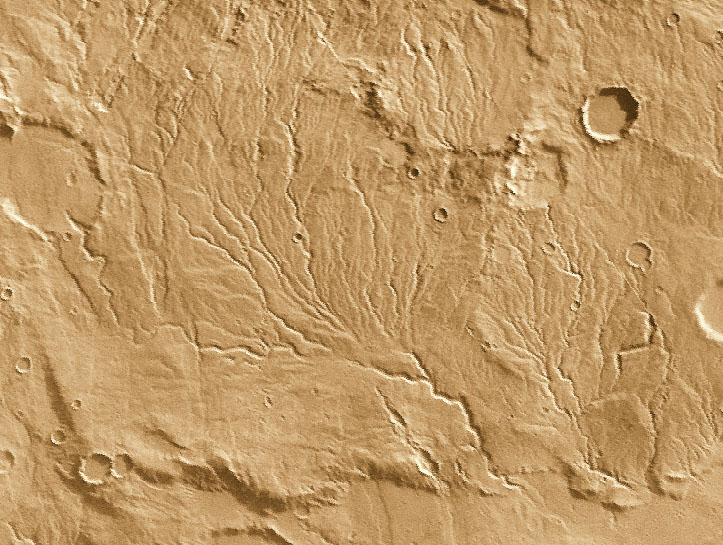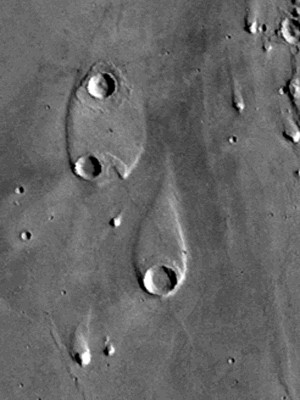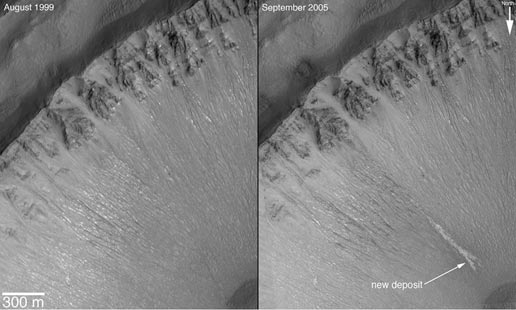Marte teve mares e rios. Desde há quantos anos não os tem?
De facto existem diversos evidências de que outrora existiram rios e mares em Marte.
Existem diversos indícios na superfície marciana que apontam para a existência de água corrente no passado especialmente
no hemisfério sul. Existem canais fluviais, crateras com o fundo plano (deposito de sedimentos), sinais de
erosão provocados por água corrente e vestígios de inundações repentinas. Isso deve ter acontecido, todavia,
num passado remoto do planeta uma vez que essas estruturas apresentam já bastantes crateras sem sinais de erosão
significativa.

Fig.1: Canais fluviais onde se julga ter existido água corrente em Marte. A imagem é muito semelhante à dos canais fluviais observados em desertos da Terra /Rivers channels, where we think running water may have existed on Mars. This image is very similar to river channels in Earth deserts (NASA).

Fig.2: Ilhas marcianas resultantes de um grande inundação no passado remoto do planeta. Nota-se claramente a direção tomada pela água / Martian islands resulting from a big flood in the far past of the planet. We can clearly see the direction taken by water (NASA).
A água no estado líquido pode existir mediante uma pressão e temperatura adequadas. A combinação destes valores no
Marte atual apenas possibilita a existência de água no estado sólido ou no estado vapor (como nos nossos congeladores).
A existência de água líquida no passado implica que a atmosfera do planeta era então mais densa e mais quente.
Para onde foi a agua marciana? Na atmosfera não está. Pode estar nas calotes polares. Sabemos, no entanto, que as
calotes polares não podem ser apenas água gelada. A temperatura no inverno marciano desce ao ponto de possibilitar a
congelação do dióxido de Carbono e, portanto, parte do gelo é também CO2 . Com a chegada da primavera as calotes polares recuam.
A Mariner 9 em 1972 registou o recuo da calote polar norte. No entanto com a chegada do Verão o recuo deteve-se
abruptamente ficando uma calote polar residual (correspondendo talvez à água). A existência de água gelada foi
finalmente confirmada em 2004 pela Mars Express.
Existem indícios da existência de água não só nos polos mas também noutras regiões. Neste caso a água está gelada no
subsolo. Existem sinais de que emergiu água do subsolo no momento da formacão de algumas crateras. Existem também vestígios de água corrente relativamente recentes.

Fig.3: Imagem do mesmo local captada em 1999 e em 2005. Na imagem mais recente pode observar-se um depósito de material que antes não existia. Isto pode indicar a existênica de água corrente no subsolo no presente / Images from the same location, taken in 1999 and 2005. In the most recent image, we can observe a deposit that wasn't there before. This may suggest the existence of running water in the undersoil region today (NASA).
De acordo com o Lunar and Planetary Observatory [http://phoenix.lpl.arizona.edu/mars151.php] os canais fluviais datam em média de há cerca de 2000 milhões de anos. No entanto o desaparecimento da água da superfície marciana deve ter sido gradual (ao longo de vários milhões de anos). De facto penso que podemos afirmar que ainda está em curso.
Mars had seas and rivers. How long has it been since it lost them?
In fact, there is substantial evidence that there were once rivers and seas on Mars.
There are several clues on the Martian surface that point towards the existence of flowing water in the past, especially in the southern hemisphere. There are river channels, craters with a flat bottom (sediment deposit), signs of erosion caused by running water and traces of flash floods. This must have happened, however, in the remote past of the planet, since these structures already have many craters without signs of significant erosion (see Fig.1 and Fig.2)
Liquid water can exist under adequate pressure and temperature. The combination of these values on Mars today only makes possible the existence of water in the solid gas state, as in our freezers. The existence of liquid water in the past implies that the planet's atmosphere was denser and warmer. Where did the Martian water go? It's not in the atmosphere. It could be in the polar ice caps. We know, however, that the polar ice caps can't be only water ice. The temperature in the Martian winter drops to the point where it is possible to freeze carbon dioxide and, therefore, part of the ice is also CO2 . With the arrival of spring, the polar ice caps retreat. Mariner 9 in 1972 recorded the retreat of the north polar cap. However, with the arrival of summer, the retreat stopped abruptly, leaving a residual polar cap, perhaps water. The existence of water ice was finally confirmed in 2004 by Mars Express.
There are traces of the existence of water not only at the poles, but also in other regions. In this case the water is frozen underground. There are signs that water emerged from the subsoil when some craters were formed. There are also traces of relatively recent running water (see Fig.3)
According to the Lunar and Planetary Observatory [http://phoenix.lpl.arizona.edu/mars151.php], river channels date back on average to around 2 billion years ago. However, the disappearance of water from the Martian surface must have been gradual, taking place over several million years. In fact, I think we can say that it's still ongoing.


